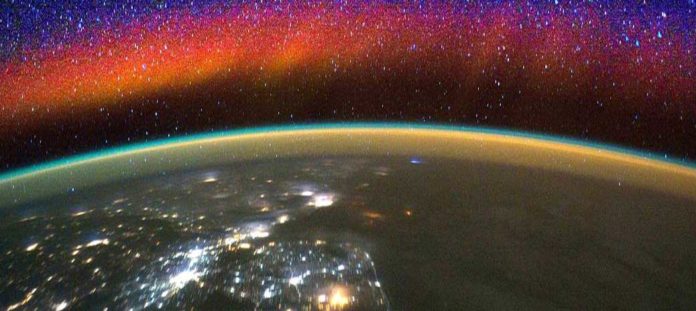Earth is the only planet where life has been found. What Does Earth Look Like from space? From space, Earth looks like a blue marble with white swirls.
But getting closer at the boundary between Earth and space, the view may be different. If you somehow happened to peer down on Earth from only 300 miles over the surface, close to the orbit of the International Space Station, you could see vibrant swaths of red and green or purple and yellow light radiating from the upper atmosphere.
This yellow light is nothing but the airglow that occurs when atoms and molecules in the upper atmosphere, excited by sunlight, emit light to shed their excess energy. Or, it may take place whenever atoms and molecules that have been ionized by sunlight collide with and catch a free electron. In both cases, they emit a particle of light — called a photon — with the end goal to relax again.
This phenomenon is like auroras, yet where auroras are driven by high- energy particles starting from the solar wind, airglow is empowered by ordinary, day-to-day solar radiation.
Credits: NASA
The airglow constantly shines throughout Earth’s atmosphere, and the result is a tenuous bubble of light that closely encase our entire planet. Just a tenth as bright as all the stars in the night sky, airglow is far more subdued than auroras, too dim to observe easily except in orbit or on the ground with clear, dark skies and a sensitive camera. But it’s a marker nevertheless of the dynamic region where Earth meets space.
Extending from around 50 to 400 miles over the surface, this locale, called the ionosphere, is an energized layer of the upper air, cooked by outrageous bright radiation from the Sun until the point when molecules break apart, offering to ascend to a mix of charged ions and electrons.
It’s neither completely Earth nor completely space, and rather, responds to both terrestrial weather — the weather we experience on Earth — rippling up from below and solar energy streaming in from above, forming a complex space weather system of its own.
Turbulence in this consistently changing sea of charged particles can manifest as disturbances that interfere with orbiting satellites or communication and navigation signals used to guide airplanes, ships, and self-driving cars.
Getting insights on the ionosphere’s extreme variability is quite difficult as it requires disentangling interactions between the different factors at play — interactions of which we don’t have a clear picture. That’s where airglow comes in.
Doug Rowland, an astrophysicist at NASA’s Goddard Space Flight Center in Greenbelt, Maryland said, “Each atmospheric gas has its own favored airglow color depending on the gas, altitude region, and excitation process, so you can use airglow to study different layers of the atmosphere. We’re not studying airglow per se, but using it as a diagnostic.”
“Airglow carries information on the upper atmosphere’s temperature, density, and composition, but it also helps us trace how particles move through the region itself. Vast, high-altitude winds sweep through the ionosphere, pushing its contents around the globe — and airglow’s subtle dance follows their lead, highlighting global patterns.”
“Two NASA missions take advantage of our planet’s natural glow to study the upper atmosphere: ICON — short for Ionospheric Connection Explorer — and GOLD — Global-scale Observations of the Limb and Disk. ICON focuses on how charged and neutral gases in the upper atmosphere interact, while GOLD observes what’s driving change — the Sun, Earth’s magnetic field or the lower atmosphere — in the region. By watching and imaging airglow, the two missions enable scientists to tease out how Earth’s weather and space intersect, dictating the region’s complex behavior.”
